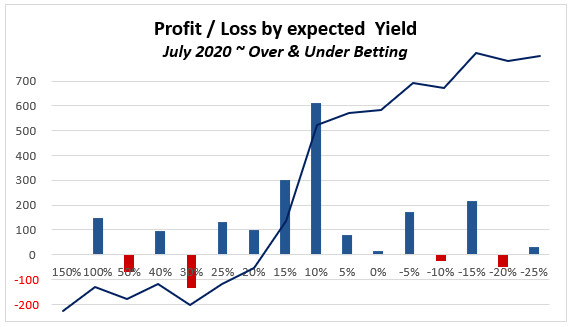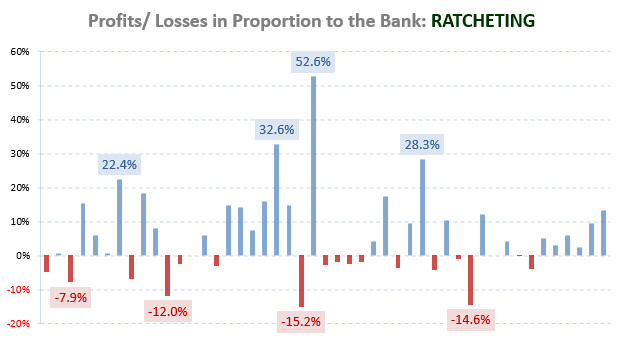
In conjunction with our regular match previews published in the German Betfair blog we are pleased to present our league match with head-to-head history ‘Value’ bet detector spreadsheet.

with H2H History
WITH Asian Handicap
(ex VAT; see below)

WITHOUT Asian Handicap
(ex VAT; see below)

0% VAT to UK customers
0% VAT to Non-EU customers
Read more: EU VAT Legislation
e-shop: Product Overview
View Your Shopping Cart
Our bet selections are always based on true odds calculations identifying mathematical ‘value’ in the markets. Of course, not every bet can win, but ‘value’ betting is the only reliable method of ensuring long-term betting profits.
‘VALUE’ bet detector: The Excel spreadsheet calculates the ‘true’ odds (= expected probabilities based on historical statistics) and then displays each ‘value’ bet recommendation. For every event included the expected values are calculated, compared to market prices, and finally the statistical probability of winning the bet is shown.
Soccerwidow follows the philosophy that only through identifying bets containing mathematical ‘value’ in the prices offered by bookmakers or exchanges is it possible to make consistent profits.
It should be noted that the spreadsheet is not a tool for automated betting. The tables provide vital information to improve the accuracy of your own predictions, and the figures do not substitute for reading salient news and applying good judgement.
The Excel spreadsheet offered for sale comes pre-filled with data from the Premier League game Liverpool v. Manchester City on 26/8/2012. Just delete or over-type this to analyse any match of your choosing.
Read a few sample match previews which apply ‘League Games with H2H History’ calculations:
- 26.8.2012 English Premier League: Liverpool v. Manchester City – Statistical Match Analysis & Football Betting Predictions
- 6.8.2012 Norwegian Tippeligaen: Stabæk v. SK Brann – Statistical Match Analysis & Football Betting Predictions
- 5.8.2012 Belgian Jupiler League: Zulte-Waregem v. Gent – Statistical Match Analysis & Football Betting Predictions
Notes: Adjust the picture quality at the bottom of the screen above by clicking on the ⚙ button (to the left of the YouTube logo), then click on ‘Quality’ and choose a higher resolution as desired. Go to full screen mode by clicking on the box symbol (to the right of the YouTube logo).
Supporting Videos
Data Sourcing: Learn where to find historical match data and download it from www.football-data.co.uk to make your own Excel store of statistics.
Data Input: Historical match results and head-to-head data input to populate the Value Bet Detector ready for input of the best odds you can find.
Frequently asked questions:
Can I use the spreadsheet in other leagues?
Yes, the calculations apply for any league in the world. The only parameters are that the game in question must be between two teams which have played at least their last 25 home or away games in the same league. The calculations are based on the home team’s last 25 home games and the away team’s last 25 away games, in the same league. Also, both teams must have played the corresponding fixture at least 6 times in the last 10 years (in other words, the home team has hosted the away team at least 6 times in all competitions (not friendlies) in the last 10 years).
How long does it take to enter historical data into the spreadsheet?
This is a manual procedure and you will quickly find which sources are best for the full-time and half-time results of both teams in the 25 matches to be analysed, plus the head-to-head encounters. We recommend Football-Data, Betexplorer, Oddsportal and Soccerway, although there are a host of other sites specialising in historical statistics.
At the start, you will find data collection will take about 30 minutes per match including entering the best bookmaker odds you can find (try Betfair and Oddschecker).
Are the formulas for the spreadsheet calculations visible?
Yes, we have hidden none of the formulas.
Exactly which historical records do I have to input?
The full-time and half-time scores for both team’s last 25 matches (home games only for the home team, away games only for the away team), plus the same for the head-to-head encounters over the last 10 years.
What knowledge is required?
You should already have a understanding of odds and how they are calculated. The spreadsheet is just a tool to identify potential bet candidates. You will need to understand what is meant by the term ‘value’ and also have a good idea how to spread risk with a well-structured betting portfolio. The spreadsheet is intermediate level, and you should be become entirely familiar with its mechanics before committing money to any bet recommendations suggested by the spreadsheet.










Hi Rado,
We are pleased to hear about your success and a yield of 7.5% is very respectable indeed.
Higher yields are possible when looking at outcomes with higher odds and the underdogs market is of especial interest.
Bookmakers tend to overprice underdogs in the vast majority of games to encourage money away from the favourites, which punters (unfortunately) see as a safer bet.
You would be surprised at how often the underdogs win and yields over 50% are perennially available in certain leagues.
If you go after these opportunities, of course you have to be emotionally immune to the longer losing streaks that naturally attach.
280 bets is a fair sample size. Our ‘rule of thumb’ tends to be 500 bets or more before you can say it is a statistically significant number.
I would be interested to hear from you again once you reach that milestone.
As for tweaking the calculator, well done! It is impossible for us to design one for everyone’s individual taste, and all we can do is provide the tools that make it possible to achieve a successful strategy.
But we can say hand on heart that winning at sports betting is an art – you just have to master the basics before you can begin applying your own thoughts and ideas to the canvass.
Thanks for your valued comment and we hope your run of success continues!
Hello, I’ve purchased the Value Detector several months ago and I am very pleased. It helped me understand how vitally important it is that absolutely all the bets that one places contain mathematical value compared to the odds at which they are placed.
However, I made one very important tweak to it – it now makes THREE separate checks to the so called “true odds”:
– the first with the default 50/50 weighing of the h2h results with the last 25 matches
– the second with 66.7/33.3 weight advantage to the recent 25 matches of bot teams and
– the third with 100% advantage to the recent 25 matches (that is, it completely omits the direct H2H results and calculates the true odds only using the recent matches)
Once these three checks have been complete, I delete the 10 “oldest” matches of both teams and run the three checks once again, but with only 15 recent matches for both teams (this way i give some importance to the more recent form)
ONLY IF a bet passes all SIX checks (the calculated true odds are lower than what is offered on betfair or bet365), then I will begin consider betting on it.
So far, it has been a nice ride, with 280 bets on soccer and a ROI of 7,5%. I have been doing this for 3 months now.
My question to you, Soccerwidow, is when do you think you can say that you have found a winning strategy? How many successful bets do you need to make in order for their count to be a viable statistical example?
hello rado , im interested in knowing how did your betting season go ?
Japanese league is about to start, it has 3 stages, the 3rd one is play offs. I prepare manually historical results data sheets (the same like from football data co uk site). Should I include 3rd round play offs in my own made sheets? I’m not sure about it, because 3rd round play offs doesn’t look like a round of regular season to me.
Sorry, I was not very accurate with my question about column Z. I understand it’s for O 1.5 etc., but I meant why it’s called “”NO” bets” in row 18 and “Betfair” in in row 19?
Regarding the same type of table for “win to nil”, “clean sheet” and “win both halves” markets, “Real” odds in column Y correspond “true” odds of “Win to nil”- No, CS-No, WBH-No?
Hi Jo,
The VC was developed whilst I was writing my match previews for Betfair. Therefore this heading “NO Bets Betfair” in the VC.
If you use Betfair for betting then you open for example the “Under 1.5 Goals” tab. If you bet on “Yes” this means you bet on under, “No” is over.
Sorry for the confusion,
Soccerwidow
Hi Soccerwidow,
I don’t understand why I get negative Value II in Over/Under X goals when I have higher “best” odds in column P than “true” odds in column O. I type “back” in column R and Value II is negative. In other cases I have automatic “B” in column Q or/and “Back U 3.5” in column S and Value II is positive, but if I type “back” in column R, Value II turns negative.
And I don’t understand what “NO” bets Betfair mean in column Z?
This is a little “bug” in the spreadsheet. You have to type exactly in the respective line, either:
Back O 1.5, Back O 2.5, etc.
or
Back U 1.5, Back U 2.5, etc.
Just “Back” returns the opposite – the spreadsheet doesn’t know what to do.
Sorry for the confusion, it’s only an Excel spreadsheet.
The Over/Under calculations are made for U 1.5, U 2.5, …, U 6.5
The column “Z” are the calcualated prices for O 1.5, O 2.5, etc.
Hello Soccerwidow.The last 25 matches of each team must be only league games or league+cup ?
Hi Sergiu, league games only.
Cup games are something totally different. Most teams don’t know each other, they play against other division teams. It’s just complicated.
Hi, I purchased your value bet calculator awhile ago and had a question regarding the head to head games. I noticed that there is a minimum of 6 and max or 10 games. So wouldn’t 6 games give a weight to the formula by 25% and 10 games give a weight to 40%. So with 6 being the minimum wouldn’t this make the results inaccurate since there is a variation of 4? I hope im making sense. Best regards, Amy
Seasons greetings from Malaysia. I have a question pertaining to the Value Detector if you don’t mind.
I’ve just a completed 5-year study of the Japanese leagues using the value detector sheet. I used Pinnacle Sports’ closing odds instead of using the highest to be more realistic and League 2’s yield was a loss of 5%. Pinnacle Sports’ average over-round was 3.9% so quite a reasonable over-round.
So are there some leagues that are either too random, or possibly too predictable, that it’s not possible to make a profit? Or do they all make a profit in the long run and this is just an anomaly?
Cheers!
Hello again Mark,
Thanks for taking the trouble to write.
You will find that most divisions outside the top tier league in any country will return negative figures across the board.
The overround is usually so large on these leagues that the odds are simply not high enough to justify committing money to.
The reason for this is that the bookmakers have a real problem trying to balance their book when demand for the bets is not high.
With any fringe division, such as J-League 2, the amount of money turned over and the frequency of the bets struck mean that any bookie will drop odds across the board, making it more expensive for you to buy the bet (in terms of value). When demand is low, the price is low.
I would wholly recommend sticking with the premier leagues in any country you wish to analyse. In fact, any league where demand for bets is high. Prices will be higher, there will be more bookmakers to choose from, and there will be more ‘value’ opportunities because of these.
In answer to your last question, every league is different but patterns can be detected. No league is too predictable! 🙂 It is possible to make a profit from any league where historical statistics (results and odds) can be filtered to show the inflection points in that league (i.e. the point where profits turn to losses or losses turn to profits).
In terms of making an overall profit, you will need numerous systems to support each other and an expected bet count of at least 500 in total per season, although more is preferable. (The Law of Large Numbers).
Hope this helps and thanks again for your contribution.
I have enjoyed using your value bet detector and compliment you on a well thought out and intelligent spreadsheet.
I do however have some recommendations to maybe improve your product.
1. You mention in the notes that column T shows the likelihood of success. Column T is blank.
2. You say that column R shows potential bet candidates. Column R is actually the custom column where the user inputs their own recommendation?
3. Could you explain the criteria that makes a back or lay appear in column S? I have seen on occasion a bet that looks real value but doesn’t trigger this condition.
4. On the home sheet, the home team name is brought in from the main sheet via a function. If you had this as a column where you entered the value it would save cutting and pasting twice to enter data values from the results information that has been acquired. The same could be said with the HTHG/HTAG etc. Columns could be placed in an order so you could enter data in one go instead of several copy and pastes. This also applies to the away sheet.
5. The H2H should be in the same format as the away/home tabs for ease of data entry too.
I have found a way of quickly getting the data together that may work for others. It takes a while to set up but once done gets the information easily and in the format that your tabs are in.
1. download the last 10 years results for each league from football-data as recommended by you.
2. Put the last ten years results in one excel sheet in date order.
3. Look at a site like soccerstand to see the H2H data. This is the quickest filter for a bet recommendation. If there isn’t 6 matches in 10 years go no further.
4. Check both teams home results to see if they are both from the same league. This filters out relegated/promoted teams.
4. When a possible fixture is identified use the data tab and the filter in your 10 years of results spreadsheet to request the info relevant to the home and away teams and copy and paste into the value spreadsheet.
5. in the data tab use the sort facility and sort the home and away teams in two levels to show previous meetings for the H2H.
6. Add other meetings ie, cup/different league etc into the H2H.
7. Your sheet then does the calculations.
regards
timmyp
Hi Graziano,
HwBH = Home team wins both halves
AwBH = Away team wins both halves
Hope this helps!
What is HwBH and AwBH?
Hi SoccerWidow,
I purchased your valuebet dector, however, on some match I cannot have the H2H minimum of 6 matches. For example, there were only 1 H2H during the past 10 years, how should I proceed without the H2H data?
Your feedback will be greatly appreciated.
Looking forward to your response!
Best regards,
XNX
Hi XNX,
the VC is ONLY for league games with H2H history! This is a very important correction factor.
If you don’t have H2H data, i.e. the teams have not played against each other in the last 10 years, then leave it. The calculations are totally different, and much more complicated.
Hi, for domestic cup matches which spreadsheet would be best to use would it be the domestic one with head to head or the international club competition without head to head? I was just confused because for example tommorow Middlesbrough who play in the championship are playing Burton Albion who are in league 1 but both teams are in really good form in there respective leauges so it may confuse the true odds.
Hi, if I can’t get the odds I desire before kick off is it ok to wait for in-play for the odds to reach what i need? for instance say i want to lay the away team but their odds are too low, could I wait and see if the home side scores or if the match remains a draw then lay the away side once my odds target has been reached?
Hi Marc, yes, this a possible betting strategy. Once you worked out an algorithm which works, it’s advisable to use a bot. Otherwise it’s quite tiresome to sit in front of the computer all the time and wait for a goal. Here an article on this topic: Review and Tips: MarketFeeder Pro – Betfair Bot
Hi soccerwidow,
Shouldn’t we include an element of Home Field Advantage in our calculations ?
I wonder your views on that !
Hi Socrates,
the “Home Field Advantage” is factored in by including the H2H history in the calculations as a correction factor. The more often the home team won against their opponent in the past the stronger the factor.